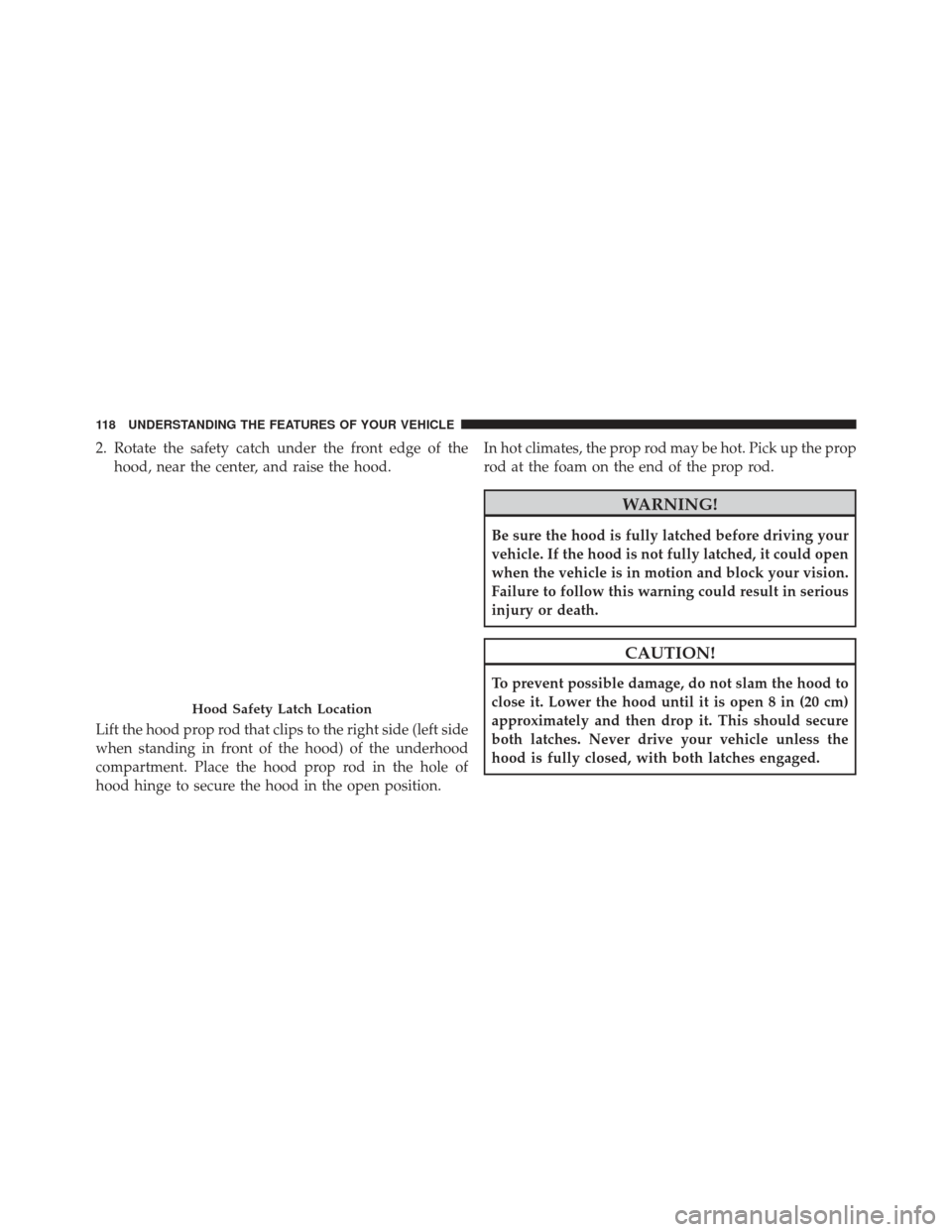Page 97 of 350
UNDERSTANDING THE FEATURES OF YOUR VEHICLE
CONTENTS
�MIRRORS .............................98
▫ Inside Day/Night Mirror .................98
▫ Automatic Dimming Mirror — If Equipped . . .99
▫ Power Mirrors ...................... .100
▫ Folding Mirrors ...................... .101
▫ Heated Mirrors — If Equipped ...........101
▫ Sun Visors ......................... .102
� BLUE&ME™ HANDS-FREE COMMUNICATION —
IF EQUIPPED ........................ .102
▫ Overview .......................... .102▫
The Hands-Free Kit ....................103
� SEATS ..............................110
▫ Front Seats Forward/Rearward Adjustment . . .110
▫ Recline Adjustment ....................111
▫ Seat Height Adjustment .................112
▫ EZ Entry Feature ......................112
▫ Memory Feature ......................113
▫ Heated Seats — If Equipped .............114
▫ Head Restraints .......................115
� TO OPEN AND CLOSE THE HOOD .........1173
Page 119 of 350
TO OPEN AND CLOSE THE HOOD
To open the hood, two latches must be released.1. Pull the bottom of the RED hood release lever, located
on the left kick panel, rearward.
Push Button
Hood Release Lever
3
UNDERSTANDING THE FEATURES OF YOUR VEHICLE 117
Page 120 of 350

2. Rotate the safety catch under the front edge of thehood, near the center, and raise the hood.
Lift the hood prop rod that clips to the right side (left side
when standing in front of the hood) of the underhood
compartment. Place the hood prop rod in the hole of
hood hinge to secure the hood in the open position. In hot climates, the prop rod may be hot. Pick up the prop
rod at the foam on the end of the prop rod.
WARNING!
Be sure the hood is fully latched before driving your
vehicle. If the hood is not fully latched, it could open
when the vehicle is in motion and block your vision.
Failure to follow this warning could result in serious
injury or death.
CAUTION!
To prevent possible damage, do not slam the hood to
close it. Lower the hood until it is open 8 in (20 cm)
approximately and then drop it. This should secure
both latches. Never drive your vehicle unless the
hood is fully closed, with both latches engaged.
Hood Safety Latch Location
118 UNDERSTANDING THE FEATURES OF YOUR VEHICLE
Page 277 of 350
WARNING!
•Take care to avoid the radiator cooling fan when-
ever the hood is raised. It can start anytime the
ignition switch is ON. You can be injured by
moving fan blades.
• Remove any metal jewelry such as rings, watch
bands and bracelets that could make an inadvertent
electrical contact. You could be seriously injured.
• Batteries contain sulfuric acid that can burn your
skin or eyes and generate hydrogen gas which is
flammable and explosive. Keep open flames or
sparks away from the battery.
1. Set the parking brake, place the transmission into PARK and turn the ignition to LOCK.
2. Turn off the heater, radio, and all unnecessary electri- cal accessories.
Battery Posts
1 — Positive (+) Post (Covered With Protective Cap)
2 — Negative (-) Post
6
WHAT TO DO IN EMERGENCIES 275
Page 292 of 350
NOTE:DO NOT REMOVE THE COOLANT PRESSURE
CAP WHEN THE COOLING SYSTEM IS HOT.WARNING!
You or others can be badly burned by hot coolant
(antifreeze) or steam from your radiator. If you see or
hear steam coming from under the hood, do not open
the hood until the radiator has had time to cool.
Never try to open a cooling system pressure cap
when the radiator is hot.
Power Electronics and Battery Thermal
Management Systems — Cooling Pressure Caps
The caps must be fully tightened to prevent loss of
coolant (antifreeze).
The caps should be inspected and cleaned if there is any
accumulation of foreign material on the sealing surfaces.
290 MAINTAINING YOUR VEHICLE
Page 296 of 350

Disposal Of Used Power Electronics and Battery
Thermal Management Systems Coolant
Used antifreeze is a regulated substance requiring proper
disposal. Check with your local authorities to determine
the disposal rules for your community. To prevent inges-
tion by animals or children, do not store antifreeze in
open containers or allow it to remain in puddles on the
ground. If ingested by a child, contact a physician
immediately. Clean up any ground spills immediately.
Points To Remember
If an examination of your underhood compartment
shows no evidence of cooler or hose leaks, the vehicle
may be safely driven.
•Do not overfill the coolant recovery bottles. •
Check coolant (antifreeze) freeze point in the coolant
recovery bottles. If coolant (antifreeze) needs to be
added, contents of coolant recovery bottles must also
be protected against freezing.
• If frequent coolant (antifreeze) additions are required,
or if the level in the coolant recovery bottles does not
drop when the engine cools, the cooling system should
be pressure tested for leaks.
• Maintain coolant (antifreeze) concentration at 50%
OAT coolant (antifreeze) (minimum) and distilled/
deionized water for proper corrosion protection of
your engine which contains aluminum components.
• Make sure that the coolant control systems recovery
bottles overflow hoses are not kinked or obstructed.
• Keep the front of the coolant control systems clean. If
your vehicle is equipped with air conditioning, keep
the front of the condenser clean.
294 MAINTAINING YOUR VEHICLE
Page 347 of 350

Air Pressure.......................... .240
General Information .....................240
High Speed .......................... .243
Inflation Pressures ...................... .241
Life of Tires .......................... .246
Load Capacity ........................ .236
Pressure Warning Light ...................159
Quality Grading ....................... .333
Radial .............................. .243
Replacement .......................... .247
Rotation ............................. .250
Safety .............................. .230
Sizes ............................... .231
Snow Tires ........................... .244
Spinning ............................ .245
Tread Wear Indicators ....................246
Tire Safety Information .....................230
To Open Hood ...........................117
Towing ............................... .258Disabled Vehicle
....................... .280
Recreational .......................... .258
Traction ............................... .216
Traction Control ......................... .225
Trailer Towing .......................... .258
Transaxle Automatic .............................32
Transmission Automatic ........................... .209
Transmitter Battery Service (Remote Keyless Entry) . .37
Tread Wear Indicators ..................... .246
Turn Signals ............................ .120
UCI Connector .......................... .193
Uniform Tire Quality Grades .................333
Universal Consumer Interface (UCI) Connector . . . .193
Untwisting Procedure, Seat Belt ................52
Vehicle Identification Number (VIN) .............7
10
INDEX 345